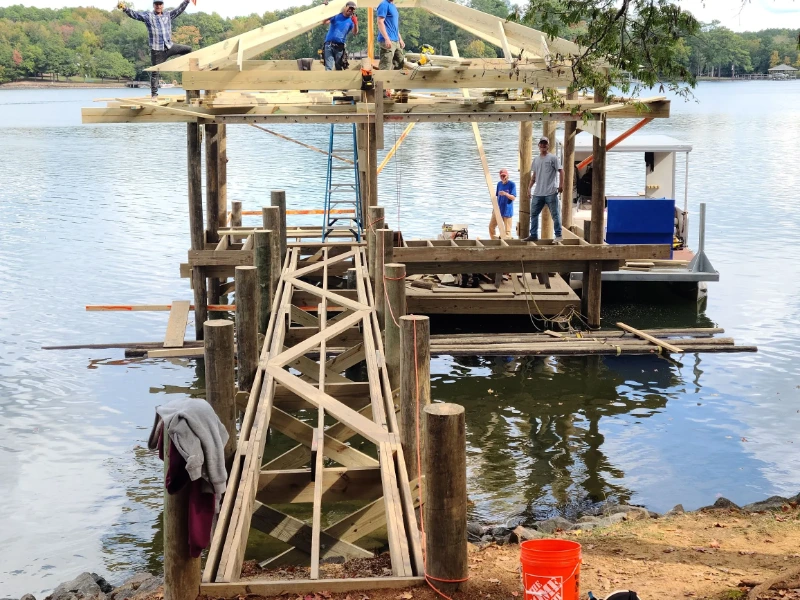DIY Tips for Simple Dock Repairs You Can Manage
DIY Tips for Simple Dock Repairs You Can Manage
Blog Article
Efficient Dock Repair Service Techniques: Ensuring Structural Stability
Making sure the structural integrity of docks via reliable repair work methods is extremely important for the durability and safety and security of marine facilities. This involves a multi-faceted technique starting with detailed inspections making use of advanced technologies like finder tools and remotely operated cars (ROVs) to spot both noticeable and concealed damages. Ultimately, choosing the appropriate repair work materials, such as corrosion-resistant alloys and composite materials, is vital for toughness. Architectural support techniques, consisting of the application of cross-bracing systems and load-distribution plates, play a vital role in mitigating stress and anxiety factors. The significance of these strategies ends up being apparent when discovering innovative repair work methods and preventative maintenance approaches.
Examining Dock Damages
Analyzing dock damage is an important initial action in making sure the architectural honesty and safety of any kind of docking facility. Trick facets to check out include the dock's foundation, pilings, decking, and equipment (Dock Repairs).
Architectural engineers or certified assessors commonly execute these analyses making use of specialized devices and methods. For example, underwater evaluations may use sonar equipment or remotely operated lorries (ROVs) to find immersed damages. Over water, visual inspections are matched by utilizing wetness meters and various other analysis tools to reveal underlying concerns not instantly noticeable to the naked eye.

Finding Fixing Materials
Picking the appropriate repair work materials is a pivotal step in the dock restoration procedure, one that directly influences the durability and performance of the repaired structure. Material selection have to be driven by variables such as ecological conditions, load-bearing requirements, and compatibility with existing dock parts.
In addition to timber, composite materials are increasingly popular because of their sturdiness and low upkeep requirements. Compounds, usually made from a blend of plastic and wood fibers, offer excellent resistance to rot, bugs, and UV damages. For steel anchors, picking corrosion-resistant alloys such as galvanized steel or marine-grade aluminum is important to stop corrosion and guarantee structural honesty in saline water conditions.
Epoxy materials and marine-grade sealants are crucial for fixing splits and securing joints, providing a waterproof barrier and improving the dock's general strength. By diligently picking top notch products, dock repair services can attain resilient outcomes, consequently securing against future degradation and guaranteeing secure, trusted use.
Structural Support Strategies
Reliable architectural support techniques are essential in making sure the stability and durability of dock repair work. This technique is especially reliable for anchors exposed to hefty tons or harsh ecological conditions.
Another vital strategy is the application of fiber-reinforced polymers (FRP) These materials supply high strength-to-weight proportions and exceptional resistance to rust, making them ideal for reinforcing wooden or concrete anchors. FRP can be used in strips or sheets and bound with epoxy resins to boost structural stability.
Bracing and securing systems also play a critical duty in architectural reinforcement. Cross-bracing, utilizing metal or wood beams, can combat side forces, decreasing swaying and motion. Anchoring systems, such as helical piers or driven stacks, provide a steady structure by transferring loads to much deeper, more secure soil layers.
Lastly, the integration of load-distribution plates can aid disperse weight a lot more equally throughout the dock's surface area, alleviating localized stress points. These methods collectively guarantee that docks continue to be robust and safe, capable of withstanding the rigors of their functional environment.
Advanced Repair Work Techniques

One more sophisticated method entails undersea welding, which permits for repair services to be performed without the demand to dewater the location. This approach is particularly helpful for addressing architectural concerns in submerged dock components, guaranteeing marginal disruption to procedures. Enhanced welding strategies, coupled with robotic systems, deliver accuracy and reliability, thereby expanding the life expectancy of the dock.
Additionally, cathodic defense systems are applied to avoid deterioration in metal dock structures. By making use of sacrificial anodes or pleased existing systems, these methods properly minimize the electrochemical procedures that bring about product degeneration.
Last but not least, progressed monitoring modern technologies, such as structural wellness monitoring (SHM) systems, give real-time information on the problem of dock check my site structures. These systems make it possible for positive maintenance and timely interventions, ultimately making certain the long-lasting structural integrity of the dock.
Upkeep and Prevention
Maintenance and prevention are essential principles that underpin the durability and security of dock frameworks. Regular assessments are vital, permitting early discovery of wear and tear, possible weaknesses, and ecological influences. A positive strategy, involving routine checks for corrosion, rot, and architectural shifts, alleviates pricey repair work and extends the dock's functional life.
Safety nets should include applying protective coverings to steel elements to defend against rust and utilizing treated wood to stand up to degeneration. Additionally, making sure proper drain and ventilation can avoid water accumulation, which is an usual reason for structural degradation. Integrating quality products and sticking to supplier guidelines throughout construction and fixing phases also play critical roles in boosting durability.

Educating workers in dock upkeep best methods makes sure consistent application of safety nets. Leveraging technical advancements, such as drones for examinations and sensing units for real-time monitoring, can additionally improve maintenance initiatives. By prioritizing maintenance and avoidance, dock proprietors can make certain structural stability, operational safety, and cost-efficient management over the dock's lifespan.
Final Thought
Finally, keeping the structural integrity of marine centers requires comprehensive dock repair strategies. Extensive examinations article using sophisticated tools discover both visible and hid problems, while the option of appropriate fixing products improves sturdiness. Carrying out architectural support methods addresses stress points successfully. Advanced repair strategies, coupled with regular upkeep practices, make sure the dock remains operational and secure under varied ecological problems. Taking on these methods dramatically lengthens the lifespan and functionality of marine facilities.
Guaranteeing the architectural stability of docks with efficient repair techniques is extremely important for the durability and security of aquatic facilities.Selecting the suitable repair work products is a crucial action in the dock restoration procedure, one that directly affects the durability and efficiency of the fixed framework.Reliable structural reinforcement strategies are important in making sure the stability and durability of dock fixings. By focusing on maintenance and prevention, dock owners can ensure architectural integrity, operational security, and cost-efficient management over the dock's lifespan.
In conclusion, preserving the structural honesty of marine centers necessitates comprehensive dock repair methods.
Report this page